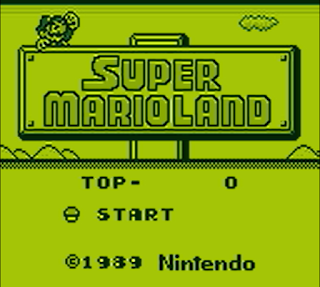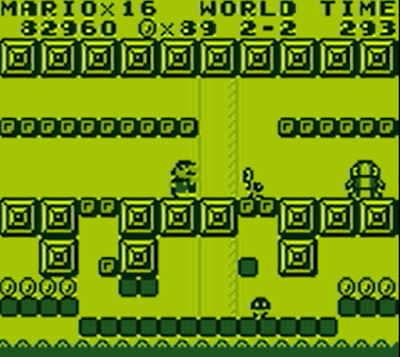 |
| It'sa me!!! |
Format: Nintendo Gameboy
Developer: Nintendo
Publisher: Nintendo
Year Released: 1989
Also Released on: Nintendo 3DS (via Virtual Console service)
Now Available on: Nintendo 3DS (via Virtual Console service)
If there's one thing you can be certain of in life, it's that within milliseconds of Nintendo releasing a new console, Mario has somehow got his mug onto some game for it. The Nintendo Gameboy was no exception, with our drainpipe dwelling friend making his miniature presence known in the 1989 game, Super Mario Land, before you had chance to say "Itsa me!" As with Super Mario Bros. on the Gameboy's bigger brother, the NES, Super Mario Land was a platforming affair, with Mario whizzing around levels, bouncing off enemies, headbutting boxes, collecting mushrooms, throwing balls of something or other, defeating enemies and rescuing princesses. But, although the formula remains the same, Super Mario Land does represent a slight departure from the norm.
 |
| Does Daisy have a moustache? |
 |
| I really can't think of anything to add here |
Princess Daisy is the ruler of Sarasaland (surely she should be Queen Daisy), but as she's got herself kidnapped, it means that Tatanga is able to take control of the kingdom and do whatever the evil things are that evil space beings do. Urgh! That's a horribly written sentence. Maybe I'll rewrite it one day. Threatening to put a stop to Tatanga's evil deeds is good old Mario, on hand to defeat him and rescue Princess Daisy. When does he ever get chance to do any plumbing? He's either got a very understanding boss, or he works for himself. It's no wonder he has to keep appearing in video games. He's got to pay the bills somehow.
 |
| That's an impressive nose you have there |
So, Mu. According to the 19th Century explorer Augustus Le Plongeon, whose name translates as Gus the Plunger (perhaps not), Mu is a lost continent. Le Plongeon claimed that, once upon a time, Mu was located in the Atlantic Ocean. Refugees from Mu went to places like Egypt and central and southern America, resulting in the development of the Egyptian and Mayan civilisations in their respective locales, explaining their similarities despite their physical distances. Other "experts" believe that Mu was located in the Pacific Ocean, and was the common origin of civilisations that sprouted up all over the world. Wherever it was located, and whatever influence it had on the rest of the world, for some reason or another, it sank into the sea and has never been seen again. Poor Mu.
 |
| My head! I really need to find a better way of opening up these secret boxes! |
 |
| 100 points for pounding an enemy into the ground. Great! |
As per usual, Mario has two modes of attack. He can jump on enemies or throw things at them. When Mario is at his tiniest, he is only able to defeat enemies by jumping on them. He gains the ability to chuck stuff after gaining the mushroom power-up to make him bigger, and then collecting a flower power-up. Mario can also use his throwing power-up to collect hard to reach coins. This is particularly handy in some bonus areas.
 |
| Coins coins coins! |
 |
| Best bonus level ever! |
Ahem. So, yes, there are plenty of pipes all over the place, and Mario can go down some of them to enter bonus areas. They mostly contain coins, sometimes a power up or two, and little else. The only problem is that, to find them, you usually have to try each pipe, until you come to the one that you need. Obviously, multiple plays will result in you memorising which ones contain the bonus areas. Some pipes also contain enemies popping out of them.
 |
| Extra Lives! Get yer extra lives here! |
 |
| Who need R-Type when you have this? |
In fact, the whole game itself is easy. It’s perhaps the easiest Mario game there is, and can be completed in about half an hour. End of level bosses don’t really pose much of a challenge at all. But, although it’s easy, it is fun. Lots of fun. Mario is a delight to control, and whizzes around the levels like a little flea. Breaking up the platforming elements are a couple of levels where Mario takes to the skies in a little plane to shoot down enemies. Again, these aren’t difficult levels, but they are fun. And this is one of the things that keeps bringing you back to the game. It isn’t one of those games that you play, complete, and never return to. You’ll find yourself returning to it time and time again, either to perfect your route, find all of the secrets, get a higher score, achieve a speed record. The game lends itself perfectly for all of these challenges but is also great if all you want is to enjoy a quick half an hour of quality platform gaming in its purest form.
 |
| Die Tagana!!! You're no Bowser! |
If you have a Gameboy, there’s a good chance that you already have this game as it is one of the must-own titles for the console. If you don’t have it, or you own anything that can play Gameboy games, you need to get this game. You need it. Show it your kids and grandkids. Show them this is what we did when games were in black and white. Or black and yellow.
RATINGS
Presentation – 80%
Typical Nintendo polish throughout. Nothing too exciting.
Graphics – 81%
The sprites are quite small and the levels are quite sparce, but they feel just right for the game, even though they feel a little non-Mario-ish.
Sound – 85%
Some fantastic tunes, unique to this game, and accompanied by familiar and suitable sound effects.
Playability – 86%
Playable from the moment you get going, simple and easy to pick up with plenty of variety.
Overall – 85%Playable from the moment you get going, simple and easy to pick up with plenty of variety.
The game became a classic from the moment it was released. It isn't the hardest of games, but was the perfect title for Nintendo's then-new handheld.
PLAYTHROUGH VIDEO
See the game from start to finish here
No comments:
Post a Comment